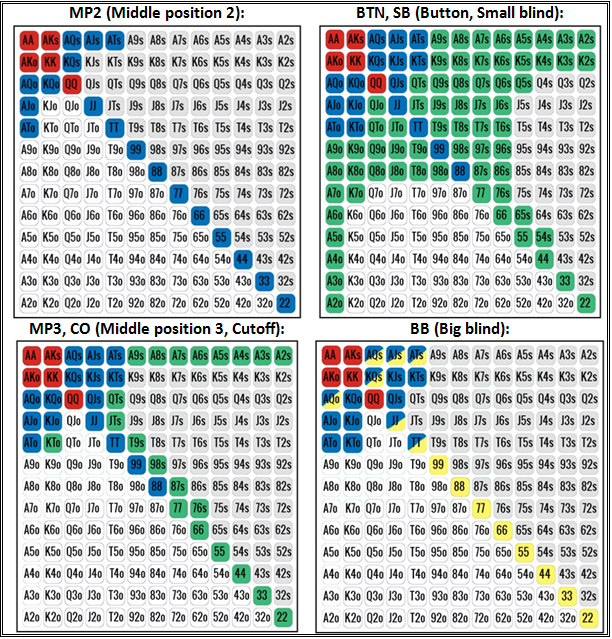Below you'll find a list of Texas Hold'em starting hands organized by relative strength.The following charts contains every 2-card possible combination you can be dealt in Texas Hold'em. Each hand is followed by its long-term winning percentage (out of 100, of course) against a specific number of opponents holding random cards. The Texas Hold’em odds of how likely hands are to unfold after the flop will help guide almost every action you make on the flop Odds On the Flop in Texas Hold’em. The flop is the turning point of a Hold’em hand. This is where you’re going to make your biggest and most expensive decisions. Pocket jacks is known as a big danger hand in Texas Hold’em. It may look good, but the chances of a higher card turning up on the flop is 52%, giving your ‘fish-hooks’ less than half a chance of survival.
- Texas Hold'em Starting Hand Odds
- Texas Holdem Starting Hands Odds Calculator
- Cached
- Texas Hold'em Odds Calculator - Card Player
Poker odds charts come in useful when you want to quickly work out the odds of winning a hand in Texas Hold'em. The most commonly used odds charts are the 'standard poker odds charts' below, which give both the percentage and ratio odds of completing your draw depending on the number of outs you have (see pot odds and drawing hands for more information).
The second set of odds charts highlight interesting odds for different situations in Texas Hold'em. These will help you get to grips with the different likelihood's and chances within the game of poker.

Standard poker odds charts.

The poker odds calculators on CardPlayer.com let you run any scenario that you see at the poker table, see your odds and outs, and cover the math of winning and losing poker hands. Texas Hold'em Omaha. As a poker player, knowing poker hand odds and rankings is crucial to knowing where you stand when calculating your odds of winning. This guide is for players from beginner to intermediate level – meaning those with a basic knowledge of poker but who don’t know how best to calculate poker odds to gauge the chances of success – and will give you everything you need to beat others when.
Other poker odds charts.
Why use these odds charts?
There are currently many odds charts on the Internet at numerous poker websites. However many of these can be tricky to use. ThePokerBank provides easy to use charts highlighting the key draws on each, which makes them simple and effective to use during play.
I am confident that these odds charts are the easiest charts that you will ever use.
How to use poker odds charts.
Poker odds charts help you to determine how much you can call when trying to complete a drawing hand, such as a flush or a straight draw. By comparing your pot odds with the odds of completing your draw, you can work out whether or not it will be profitable to call certain sized bets from your opponents.
Poker odds charts are most commonly used when working out pot odds.
It is perfectly possible to work out the odds of completing a draw in your head, but these odds charts make things much easier if you are looking for a quick reference or if you're just starting out. However, over time it is a good idea to learn the most common odds so that you no longer have to refer to any charts whilst you play.

Work out probabilities for yourself.
Don't just take my word for it or settle for the probabilities I've listed on the site, try working out probabilities for yourself. It's not as tricky or mathsy as you might think.
Texas Hold'em Starting Hand Odds
My guide on how to work out preflop hand probabilities gives a nice overview on basic starting hand probabilities. For flop probabilities and the likelihood of different combinations of cards on the flop, try the article on working out flop probabilities.
Texas Holdem Starting Hands Odds Calculator
Go back to the handy Texas Hold'em tools.
Cached
Playing poker is about playing the odds. The following list gives the odds for outcomes in Texas Hold’em hands. When you realize how heavily the odds are stacked against you, you may want to rethink going all-in before the flop with two suited cards. Use the odds to your advantage:
Texas Hold'em Odds Calculator - Card Player
1 percent (1-in-100): Percentage of time that no player holds an Ace or a King at a table in a 10-handed game
1 percent (1-in-100): Percentage of time that if you hold two suited cards, you’ll flop a flush
6 percent (about 1-in-20): Percentage of time that five community cards will give pocket suited cards a flush
6 percent (about 1-in-20): Percentage of time that you’ll be dealt a pocket pair
8 percent (about 1-in-12): Percentage of time that you’ll hit at least trips after having a pair on the flop
12 percent (about 1-in-8): Percentage of time that you’ll flop trips if holding a pocket pair
12 percent (about 1-in-8): Percentage of time that two more cards will flop in the same suit as a suited pocket pair
19 percent (about 1-in-5): Percentage of time that the five community cards will at least trip your pocket pair
32 percent (about 1-in-3): Percentage of time that you’ll pair one of your cards on the flop (with no pocket pair)
33 percent (about 1-in-3): Percentage of time that you’ll make a full house or better after having trips on the flop
35 percent (about 1-in-3): Percentage of time that you’ll make a flush on the turn or river if you have four cards to a flush after the flop